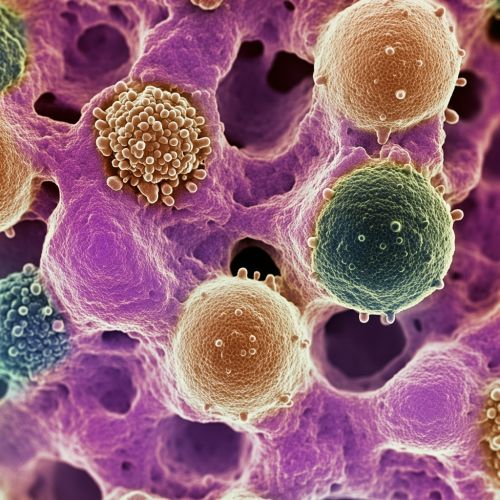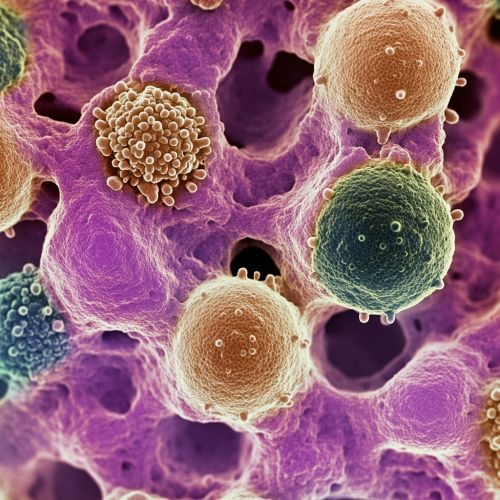HLA antigens: Difference between revisions
(Created page with "== Introduction == Human Leukocyte Antigen (HLA) antigens are cell surface proteins encoded by genes within the major histocompatibility complex (MHC) on chromosome 6. These antigens play a critical role in the immune system by presenting peptides to T cells, thereby facilitating immune recognition and response. The HLA system is highly polymorphic, which is essential for the adaptability of the immune system to a wide range of pathogens. == Structure and Function == HL...") |
No edit summary |
||
| Line 11: | Line 11: | ||
HLA Class II molecules are primarily expressed on antigen-presenting cells (APCs) such as dendritic cells, macrophages, and B cells. They present exogenous peptides, typically derived from extracellular proteins, to CD4+ T cells. The main HLA Class II molecules are HLA-DP, HLA-DQ, and HLA-DR. Each HLA Class II molecule consists of an α chain and a β chain, both of which are encoded by HLA genes. | HLA Class II molecules are primarily expressed on antigen-presenting cells (APCs) such as dendritic cells, macrophages, and B cells. They present exogenous peptides, typically derived from extracellular proteins, to CD4+ T cells. The main HLA Class II molecules are HLA-DP, HLA-DQ, and HLA-DR. Each HLA Class II molecule consists of an α chain and a β chain, both of which are encoded by HLA genes. | ||
[[Image:Detail-97599.jpg|thumb|center|Microscopic view of human leukocyte antigens on a cell surface.|class=only_on_mobile]] | |||
[[Image:Detail-97600.jpg|thumb|center|Microscopic view of human leukocyte antigens on a cell surface.|class=only_on_desktop]] | |||
== Genetic Diversity == | == Genetic Diversity == | ||
Latest revision as of 17:36, 13 August 2024
Introduction
Human Leukocyte Antigen (HLA) antigens are cell surface proteins encoded by genes within the major histocompatibility complex (MHC) on chromosome 6. These antigens play a critical role in the immune system by presenting peptides to T cells, thereby facilitating immune recognition and response. The HLA system is highly polymorphic, which is essential for the adaptability of the immune system to a wide range of pathogens.
Structure and Function
HLA antigens are divided into two main classes: Class I and Class II.
HLA Class I
HLA Class I molecules are expressed on almost all nucleated cells and present endogenous peptides, typically derived from intracellular proteins, to CD8+ T cells. The primary HLA Class I molecules are HLA-A, HLA-B, and HLA-C. Each of these molecules consists of a heavy chain (α chain) and a light chain (β2-microglobulin). The α chain is encoded by the HLA genes, while β2-microglobulin is encoded by a separate gene on chromosome 15.
HLA Class II
HLA Class II molecules are primarily expressed on antigen-presenting cells (APCs) such as dendritic cells, macrophages, and B cells. They present exogenous peptides, typically derived from extracellular proteins, to CD4+ T cells. The main HLA Class II molecules are HLA-DP, HLA-DQ, and HLA-DR. Each HLA Class II molecule consists of an α chain and a β chain, both of which are encoded by HLA genes.


Genetic Diversity
The HLA system is one of the most polymorphic regions in the human genome. This genetic diversity is crucial for the immune system's ability to recognize a wide array of antigens. Each individual has a unique set of HLA alleles, inherited from both parents, which contributes to the variability in immune responses among different individuals.
HLA Typing
HLA typing is the process of identifying the specific HLA alleles present in an individual. This is particularly important in organ transplantation, where matching donor and recipient HLA types can significantly reduce the risk of transplant rejection. HLA typing can be performed using various methods, including serological typing, polymerase chain reaction (PCR)-based techniques, and next-generation sequencing (NGS).
Role in Disease
HLA antigens are implicated in a variety of diseases, particularly autoimmune disorders. Certain HLA alleles are strongly associated with specific diseases, suggesting a genetic predisposition.
Autoimmune Diseases
Autoimmune diseases occur when the immune system mistakenly attacks the body's own tissues. Some well-known associations include:
- HLA-B27 and ankylosing spondylitis
- HLA-DR4 and rheumatoid arthritis
- HLA-DQ2/DQ8 and celiac disease
Infectious Diseases
HLA diversity also influences susceptibility to infectious diseases. For example, certain HLA alleles are associated with either increased resistance or susceptibility to diseases such as malaria, HIV, and hepatitis.
Clinical Applications
The understanding of HLA antigens has several clinical applications, including organ transplantation, disease diagnosis, and personalized medicine.
Organ Transplantation
HLA matching between donor and recipient is crucial for the success of organ transplants. Mismatched HLA antigens can lead to graft rejection, where the recipient's immune system attacks the transplanted organ. Immunosuppressive drugs are often used to mitigate this risk, but close HLA matching remains a key factor in transplant success.
Disease Diagnosis
HLA typing can aid in the diagnosis of certain diseases. For instance, the presence of HLA-B27 is a diagnostic marker for ankylosing spondylitis. Similarly, HLA typing can help identify individuals at risk for developing autoimmune diseases.
Personalized Medicine
The polymorphic nature of HLA genes makes them a target for personalized medicine. Understanding an individual's HLA type can help predict responses to certain medications and tailor treatments to improve efficacy and reduce adverse effects.
Evolutionary Perspective
The high polymorphism of HLA genes is thought to be driven by evolutionary pressures, particularly those exerted by pathogens. The diversity of HLA alleles in a population enhances the ability of the immune system to recognize and respond to a wide range of antigens, providing a survival advantage.
Balancing Selection
Balancing selection is a form of natural selection that maintains genetic diversity within a population. In the context of HLA genes, balancing selection ensures that multiple alleles are preserved, allowing for a broad repertoire of immune responses.
Pathogen-Driven Selection
Pathogens exert selective pressure on the HLA system. Individuals with certain HLA alleles may be more resistant to specific infections, leading to the preferential survival and reproduction of those individuals. This co-evolutionary arms race between pathogens and the immune system drives the diversity of HLA alleles.
Future Directions
Research on HLA antigens continues to evolve, with ongoing studies aimed at understanding their role in disease, improving transplantation outcomes, and developing new therapeutic strategies.
Immunotherapy
HLA antigens are a focal point in the development of immunotherapies, particularly for cancer. By harnessing the immune system's ability to recognize and attack tumor cells, researchers aim to develop treatments that are both effective and specific.
Genomic Medicine
Advances in genomic medicine are providing new insights into the HLA system. High-throughput sequencing technologies are enabling more precise HLA typing and the discovery of novel alleles. This information can be used to improve disease prediction, diagnosis, and treatment.
